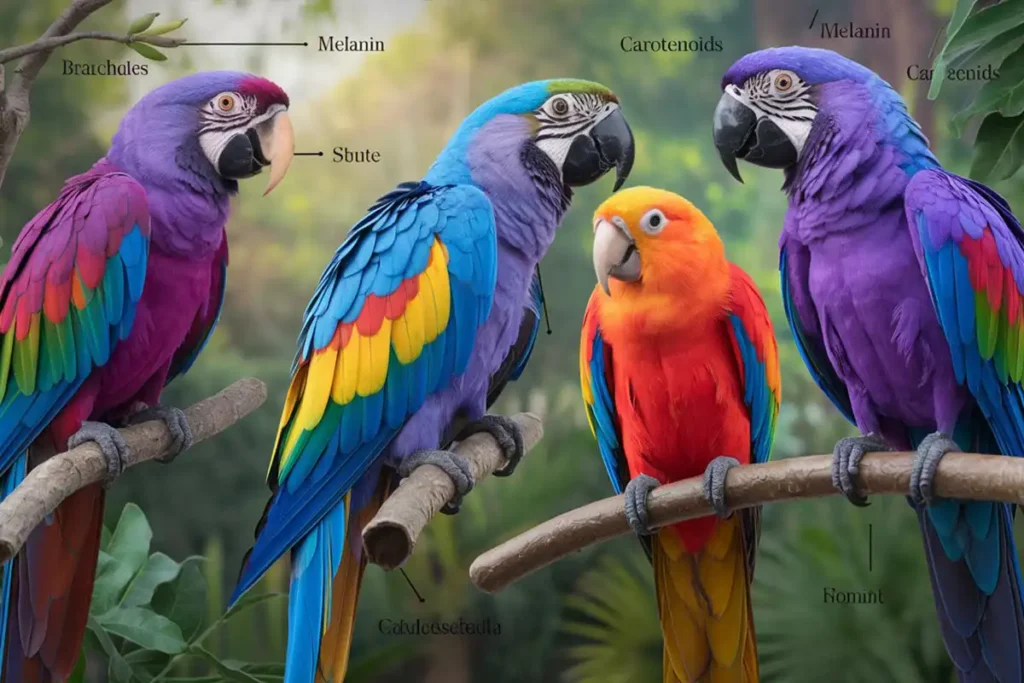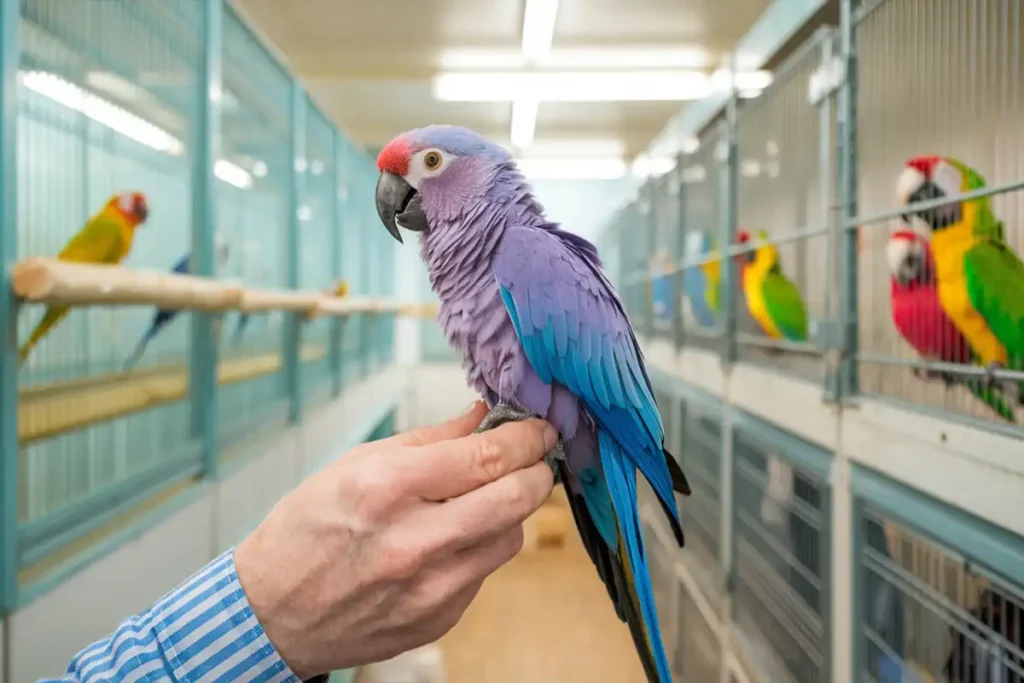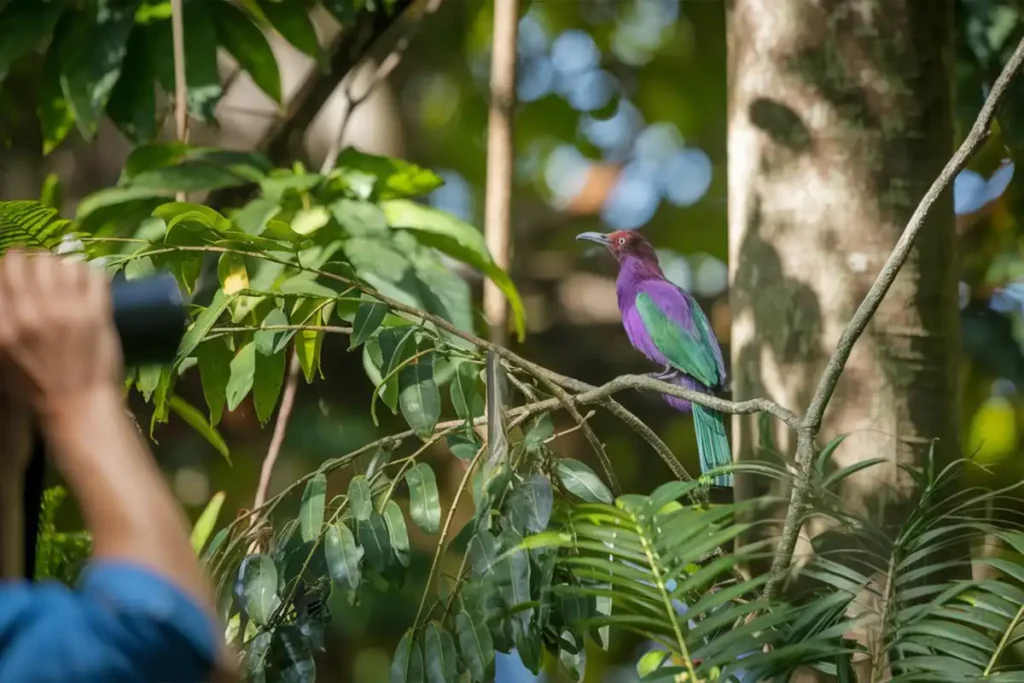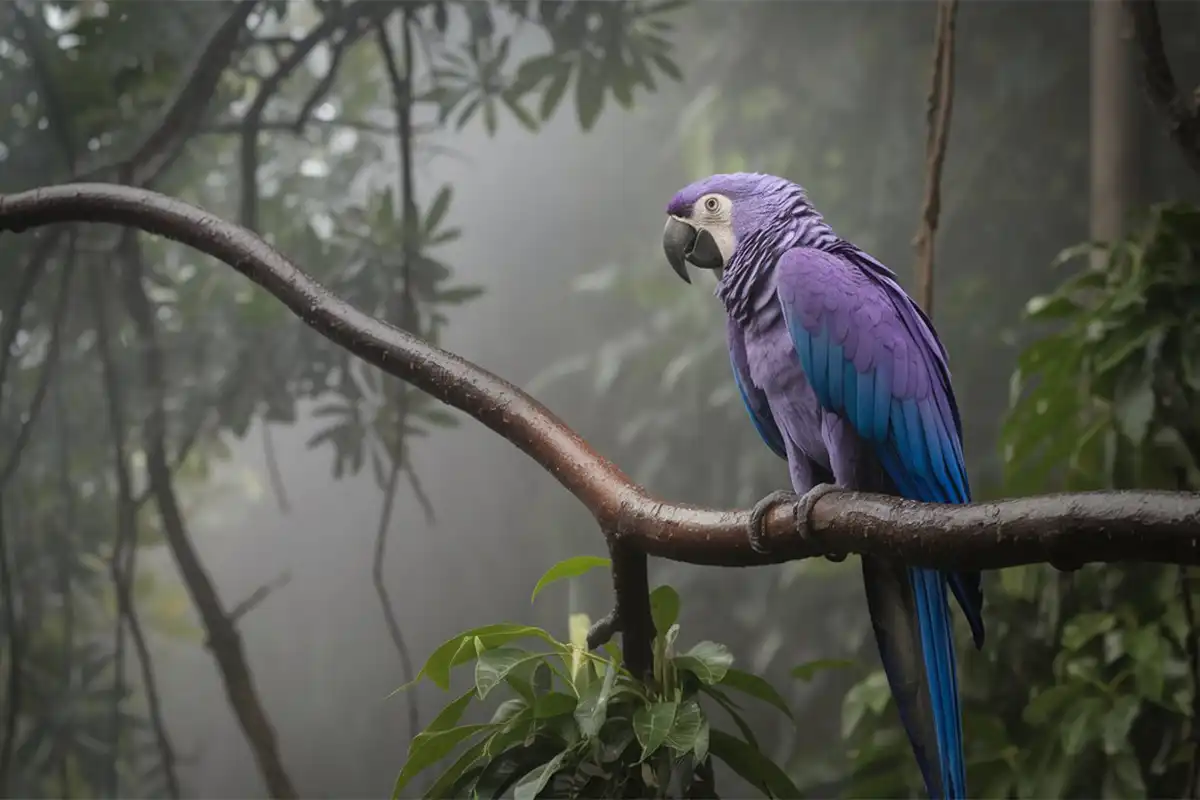Have you ever stopped mid-scroll after seeing a photo of a dazzling purple parrot and wondered, “Are purple parrots real?” You’re not alone. The idea of a bird with vibrant, violet feathers sounds like something out of a fantasy film, yet many people claim to have seen or even owned one. The truth behind purple parrots is a fascinating blend of science, rare genetics, and a splash of myth that has intrigued bird lovers and casual observers alike.
In this post, we’re diving deep into the stunning facts about purple parrots that will absolutely blow your mind. From the rarest naturally purple birds to the science of feather pigmentation and the role of aviculture in creating exotic colors, we’ll explore every angle. So whether you’re a curious birdwatcher, a pet enthusiast, or just love discovering nature’s most unusual creatures, get ready to meet some birds that are anything but ordinary.
The Mystery Behind Purple Parrots
Are Purple Parrots Real? Debunking the Myth
Bird lovers and curious minds often find themselves asking the same question: Are purple parrots real? The internet is filled with vibrant images of parrots in rich shades of violet, lavender, and plum, but most of these are either digitally enhanced or portray birds with lighting that exaggerates their natural colors.
While no officially recognized parrot species has completely purple plumage, some do feature purplish tones, especially in specific light conditions. Birds like the Violet-necked Lory or some lorikeets may appear purple, but they actually have blends of blue and red feather structures. Captive breeding and rare mutations can also create unusual color variations. However, nature rarely produces a truly purple parrot, which makes the few examples even more intriguing.
Why the Color Purple Is So Rare in Nature
Purple remains one of the rarest colors found in the natural world, especially in the animal kingdom. Unlike red or yellow, which result from common pigments, purple requires a unique combination of red pigment and blue structural coloration. That makes it incredibly hard to produce organically.
This biological rarity prompts the question many people ask: Are purple parrots real, or is it just clever lighting? In parrots, feather color typically comes from pigments called psittacofulvins, which do not produce purple tones. For a parrot to appear purple, its feathers must reflect light in an exact way that combines red and blue. Since this combination almost never happens naturally, birds with even a hint of purple become instant fascinations among birdwatchers and breeders.
Common Myths About Purple Parrots You Might Believe
Over the years, myths about purple parrots have spread widely through social media and word of mouth. Many people believe that brilliant purple parrots exist deep in untouched rainforests, hiding from human discovery, but no scientific evidence supports that idea. Some even claim that species like the Hyacinth Macaw or Eclectus Parrot are purple when they are clearly blue and green.
Others think aviculturists have successfully bred bright purple parrots, though doing so remains extremely rare and difficult. These myths confuse people and lead them to wonder, Are purple parrots real, or is the idea just a colorful illusion created by filters, clever angles, or wishful thinking? Separating fact from fiction requires a close look at genetics, biology, and lighting effects.
The Science Behind Bird Feather Pigmentation
Feather coloration in birds involves both pigmentation and structural features that bend light.Parrots make special colors called psittacofulvins. These colors help them show bright shades of red, yellow, and orange. However, they do not naturally produce purple pigments.
When someone asks, Are purple parrots real, the answer lies in how light interacts with feather structures. Purple can appear through structural coloration, where microscopic feather components reflect and scatter light to produce violet tones. This phenomenon depends on a precise combination of red pigment and blue structural elements—something rare in parrots. Most purple hues seen in parrots result from either lighting effects or intentional breeding. Understanding this process helps explain why purple parrots are more fantasy than fact, yet still rooted in fascinating science.
Bird Color Genetics Explained
How Feather Pigmentation Works: Melanin and Carotenoids
Feather color in birds comes from a combination of pigments and microscopic feather structures. Two key pigments—melanin and carotenoids—play a central role. Melanin produces darker shades like black and brown, while carotenoids, derived from a bird’s diet, create bright yellows, oranges, and reds. Together, these pigments determine the base palette for most bird species. In parrots, an additional pigment group called psittacofulvins is responsible for their famously vibrant plumage. However, none of these pigments naturally create purple.
So when people ask, are purple parrots real, the answer lies in how rare it is for pigments and structural light scattering to align in a way that mimics purple. True purple feathers are a scientific rarity, often resulting from unique structural coloration.

What Causes Unusual Colors in Birds?
Unusual bird colors often occur because of a rare combination of genetics, diet, and environmental influence. Some birds absorb unusual nutrients that alter pigmentation slightly, while others carry mutations that suppress typical feather colors or enhance alternative shades. Structural coloration also plays a key role—when microscopic feather structures scatter light in a certain way, they can create colors that don’t even exist in the pigment spectrum.
This is especially true for shades like blue and purple. So when someone asks, are purple parrots real, they’re often seeing the result of light refraction more than actual pigment. These rare colors fascinate scientists and bird lovers alike, offering a glimpse into nature’s complex design and evolutionary creativity.
Color Mutations in Parrots: Nature’s Rare Surprises
Parrots occasionally display rare color mutations that defy their typical appearance. These genetic changes can lead to parrots with entirely unexpected hues—such as pastel, blue, or even violet tones. Though these variations remain uncommon, breeders sometimes isolate and replicate them through selective aviculture. However, these birds don’t occur naturally in the wild very often. When a mutation affects pigment production or feather structure, it can result in visually stunning color patterns that grab attention instantly.
This is where the question are purple parrots real becomes tricky—because while nature sometimes surprises us with unusual coloration, most vivid purples in parrots result from breeding, not wild evolution. Still, these color variants show just how dynamic avian genetics can be.
Genetics vs. Environment in Bird Coloration
Bird coloration depends heavily on genetics, but the environment also plays a role. Genes determine a bird’s potential color palette through inherited pigmentation traits. However, diet, exposure to sunlight, and habitat conditions can influence how those colors develop.
A parrot with the genes for red feathers, for example, may appear duller if its diet lacks the right nutrients. Structural coloration adds another layer of complexity, especially in iridescent and purple hues. When people wonder, are purple parrots real, they’re often seeing a genetic anomaly intensified by optimal environmental conditions. Without both factors working together, vibrant colors—especially rare ones like purple—don’t emerge. Understanding this balance helps explain why such colors are so elusive and awe-inspiring in nature.
Exotic Purple Birds That Actually Exist
The Violet-necked Lory: A Natural Beauty
Among the most visually striking birds in the parrot family, the Violet-necked Lory stands out with its bold, iridescent plumage. Native to Indonesia and nearby islands, this lory showcases a vibrant mix of deep blue, red, and violet shades around its neck and upper chest.
The violet hues shimmer in natural light, often appearing more purple than they truly are. Its appearance fuels the curiosity behind the question, are purple parrots real, because the lory’s coloration comes remarkably close. Unlike digitally altered images online, the Violet-necked Lory’s hues are naturally occurring—thanks to a combination of pigmentation and structural feather properties. While not entirely purple, this bird offers some of the most convincing evidence that nature can produce incredibly purple-like parrots.

Are There Purple Macaws? The Truth About Hyacinth Macaws
Macaws are known for their size, intelligence, and stunning colors, but when people ask, are purple parrots real, they often point to the Hyacinth Macaw as a prime example. With its rich cobalt-blue feathers and massive wingspan, the Hyacinth Macaw might appear purple under certain lighting conditions—especially during golden hour or when photographed with a filter. However, this species is officially classified as blue, not purple.
The illusion comes from feather sheen and light reflection, not actual violet pigmentation. While truly purple macaws don’t exist in the wild, the Hyacinth Macaw’s intense coloration helps explain why many people believe they do. Its visual beauty, combined with its rarity, keeps the purple macaw myth alive in birdwatching circles.
Eclectus Parrots and Their Colorful Twist
Eclectus Parrots are famous for their extreme sexual dimorphism—males appear bright green, while females show off a striking mix of red, blue, and violet. In fact, the female Eclectus sometimes appears to have purplish feathers on her chest and wings, especially under natural sunlight.
This unique coloration leads many to wonder, are purple parrots real, since the Eclectus female looks like a strong candidate. But the truth lies in feather structure and how light reflects off their surfaces. Though not purely purple, the Eclectus Parrot displays some of the closest natural approximations. Parrots make special colors called psittacofulvins. These colors help them show bright shades of red, yellow, and orange.
Other Exotic Purple Birds in Tropical Rainforests
Tropical rainforests are places where many beautiful and colorful birds live. While true purple parrots remain rare, several exotic birds come close to that description. The Violet-backed Starling, the Purple Honeycreeper, and even certain types of lorikeets exhibit violet or purplish hues that sparkle in the forest canopy. These birds often appear more vividly colored due to the lush green surroundings and filtered sunlight of the rainforest.
These sightings make people ask, are purple parrots real, especially when birdwatchers spot iridescent plumage flashing violet overhead. Though many of these birds aren’t parrots, they show how nature occasionally brushes its wings with purple, making rainforests the ideal place to witness these rare beauties.
Aviculture and Rare Parrot Colors
How Aviculture Has Influenced Parrot Color Mutations
Aviculture is the practice of caring for and breeding birds. It has been very important in creating many unique and colorful types of parrots. Through selective breeding, aviculturists have enhanced natural mutations to produce birds in unusual colors, including pastel, blue, and even purplish tones. While these colors rarely occur in the wild, controlled environments allow breeders to isolate and amplify the traits that lead to unique feather pigmentation.
This manipulation of genetics has sparked excitement and debate in bird circles. It also leads to one popular question: are purple parrots real or just human-engineered creations? While nature sets the foundation, aviculture has undoubtedly pushed the boundaries of what’s visually possible in parrots, making certain once-unthinkable colors a reality in aviaries around the world.

Breeding for Rare Colors: Ethical or Not?
The pursuit of rare colors in parrots has become a growing trend in aviculture, but it raises important ethical questions. Breeders often select for unique traits, such as blue or violet feather mutations, to create eye-catching birds that fetch high prices. However, some worry that this emphasis on color can compromise a bird’s overall health, behavior, or genetic diversity.
When people ask, are purple parrots real, they sometimes overlook the behind-the-scenes effort that goes into creating those colors. Breeding birds should focus on taking care of the bird’s health and happiness, not just how it looks. While color mutations can be beautiful and fascinating, responsible aviculture demands careful planning, proper care, and respect for the natural limitations of each species.
Real Purple Parrots in Captivity: What’s Possible?
In captivity, breeders have more control over a parrot’s genetic line, which opens the door to rare and unexpected feather colors. Some parrots born in aviaries exhibit purple or violet hues due to mutations or deliberate cross-breeding between color variants.
Birds like the Indian Ringneck Parakeet have produced lavender or lilac morphs, which spark excitement and fuel the debate: are purple parrots real, or are they only found in cages? While nature rarely makes a bird with pure purple plumage, aviculture has made it more possible through science, patience, and careful selection. These birds, while not wild-born, show how human intervention can unlock nature’s hidden color palette—though they remain rare and highly sought-after.
The Role of Aviculture in Preserving Exotic Species
Beyond breeding for color, aviculture plays a crucial role in conserving endangered and exotic bird species. Responsible breeders maintain genetic diversity, participate in conservation programs, and provide safe environments for parrots that face habitat loss in the wild. While some people ask are purple parrots real out of curiosity, others turn to aviculture as a way to protect and study unusual species—some of which display rare and stunning feather patterns.
By preserving these birds in captivity, aviculture helps ensure their survival and gives researchers the opportunity to study their coloration, behavior, and breeding patterns. In many ways, it bridges the gap between conservation and curiosity, offering a lifeline to species on the edge of extinction.
Spotting Purple Feathers in the Wild
Birdwatching Tips for Finding Colorful Parrots
If you’re hoping to spot vibrant parrots in the wild, timing, location, and patience matter most. Early morning is ideal, when birds are most active and lighting helps reveal feather details. Use binoculars with strong clarity and visit known birdwatching spots in tropical regions.
Focus on fruiting trees and flowering canopies—parrots often gather there to feed. Bring a bird guide to help identify species based on color and markings. When someone asks, are purple parrots real, the answer often depends on a birdwatcher’s sharp eye and the right conditions. While purple parrots are rare, colorful relatives with violet hints appear frequently in the right habitats—making the search just as rewarding as the find.

Purple Feathers in Birds: What Species to Look For
While fully purple parrots are nearly nonexistent in nature, several bird species feature stunning purple or violet feathers. Look for birds like the Violet-backed Starling, Purple Honeycreeper, and Violet-crowned Woodnymph. These species may not be parrots, but they showcase the kinds of colors people imagine when asking, are purple parrots real.
In the parrot family, keep an eye out for the Violet-necked Lory or female Eclectus Parrot, both of which display purple-like shades under the right lighting. Birdwatchers who study feather details and light reflection often uncover these subtle colors. Knowing which birds naturally lean toward purple helps narrow your search and enhances your appreciation of color diversity in the wild.
Where to Find Naturally Purple Birds in the Wild
You’ll have the best chance of spotting naturally purple birds in biodiverse tropical regions where vibrant plumage thrives. Look to places like Papua New Guinea, the Amazon Rainforest, and Southeast Asian islands, which are home to colorful bird species.
These regions support species like lorikeets, starlings, and manakins—some of which show purple, violet, or iridescent highlights. So when bird lovers ask, are purple parrots real, the answer lies in these lush environments where feather color often appears more vivid. The dense canopy, bright light, and high humidity create perfect conditions for feather iridescence to shine. With a good guide and a bit of patience, you just might catch a glimpse of a truly striking purple bird.
Tropical Rainforests: The Hotspot for Exotic Purple Birds
Tropical rainforests are the most promising habitats for discovering exotic birds with dazzling colors—including purple. The thick vegetation, abundant food sources, and year-round warmth make these environments perfect for birds that rely on vibrant plumage for communication and mating.
While it’s rare to find parrots that are fully purple, birds like the Violet-necked Lory and Purple-crowned Fairy often display violet hues in these lush ecosystems. These sightings make many wonder, are purple parrots real, especially when light hits their feathers just right. Rainforests provide the rich visual backdrop that amplifies feather colors, creating unforgettable moments for birdwatchers and nature enthusiasts in search of rare avian beauty.
Conclusion
After diving deep into bird science, myths, and exotic species, one big question remains: are purple parrots real? The answer is both fascinating and complex. In the wild, no parrot species exists with completely purple plumage. However, certain parrots—like the Violet-necked Lory and female Eclectus—do show hints of purple through a mix of pigments and structural coloration. These birds, while not fully purple, give us a glimpse of what nature can do when light, feathers, and genetics align.
Selective breeding in aviculture has taken things a step further. In captivity, breeders have developed parrots with purple-like hues through rare mutations and careful pairing. These birds spark even more curiosity and keep the question are purple parrots real alive and well in birdwatching communities and among exotic pet lovers.
While the dream of discovering a truly purple parrot in the wild might still be out of reach, the journey to understand feather pigmentation, color genetics, and rare species makes the search worth it. The myth may be larger than reality, but real science, beautiful birds, and vibrant ecosystems bring us closer to the truth.
So next time you find yourself wondering, are purple parrots real, remember this: nature rarely gives us something so purely violet—but it does offer just enough to keep us amazed, curious, and forever watching the skies.
Read More About The Purple Parrots Here!
Discover the best Parrot Food in this Article.
Learn About the Top 10 Small Parrots for New Owners Here.
Read About Other Pets and breeds From HERE!
Find Out the Best stuff for your Pet On Pet MD Official.
